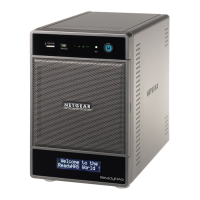Backup and Recovery
140
ReadyNAS for Home RAIDiator 4.2
2. From the drop-down list in the STEP 1 - Select backup source pane, select a backup source
that is not part of your ReadyNAS system.
Depending on how your network is configured, these options vary. Select a USB device
that is attached to your ReadyNAS system or a remote location.
If you select a remote Rsync server, you must enter the Rsync server’s host name and a
path. Depending on how the Rsync server is configured, you might need to enter a user
name and password. Whether or not you need to enter login credentials depends on how
the Rsync server is configured. For more information, contact the Rsync server’s system
administrator.
3. If necessary, enter the remote host name, the folder path, and any login credential required
to access that path.
4. (Optional) To ensure that you are able to access the remote backup destination, click the
Test connection button.
A pop-up window displays indicating whether you can access the destination.
5. From the drop-down list in the STEP 2 - Select a backup destination pane, select a backup
destination that is part of your ReadyNAS system.
Depending on how your ReadyNAS system is configured, these options vary. Select a
share, a volume, or multiple volumes. If you have previously created one or more iSCSI
targets on your ReadyNAS system, you can choose an iSCSI target as your backup
destination. For more information about creating and managing iSCSI targets, see iSCSI
Targets on page 102.
6. From the STEP 3 - Choose backup schedule pane, determine whether this backup job will
run automatically or whether it must be started manually, as follows:

